If my fiddle leaf fig isn’t growing well or starts looking unhappy, I’ve learned the potting mix is often the culprit. The right soil is one of the biggest factors in keeping this plant healthy.
Poor soil can lead to root rot, slow growth, and yellowing leaves, while the right mix helps it thrive. In this guide, I’ll show you exactly what makes the best soil for fiddle leaf figs, if you want to mix your own or buy a ready-made blend.
You’ll learn about key ingredients, simple recipes, trusted products, repotting tips, and ways to solve common soil issues. If you are ready to give your fiddle leaf fig the perfect home for its roots, let’s get started.
Understanding Fiddle Leaf Fig Soil Needs
A fiddle leaf fig thrives when its roots get the right balance of moisture, air, and nutrients. Good drainage prevents water from sitting in the soil and causing root rot, while aeration creates air pockets that help roots breathe and absorb nutrients.
Because the roots are thick and spread out, they need loose, chunky soil that gives them space to grow without becoming compacted.
The soil’s pH should be slightly acidic to neutral, between 6 and 7, so the plant can take in nutrients effectively; if it’s too acidic or too alkaline, you may see yellowing leaves or slow growth.
Key Ingredients for the Perfect Mix
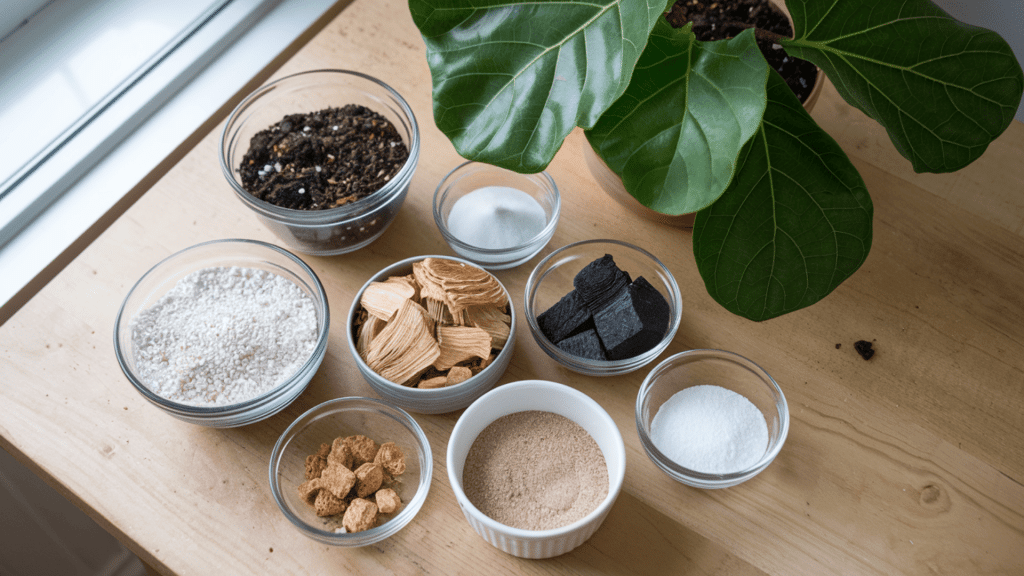
The right soil mix gives your fiddle leaf fig the drainage, aeration, and nutrients it needs to thrive. Each ingredient has a specific role, and combining them in the right way helps prevent common issues like root rot or stunted growth.
A quality indoor potting mix forms the base for fiddle leaf fig soil. It holds nutrients, supports root growth, and keeps moisture balanced. Popular options include Fox Farm Ocean Forest, Miracle-Gro Tropical Mix, and Perfect Plants Fiddle Leaf Fig Soil.
Perlite improves drainage and aeration, preventing soggy roots and root rot. If perlite isn’t available, pumice or coarse sand can be used as alternatives.
Pine bark or orchid bark adds structure to the mix, creating space for roots to spread and increasing airflow. It also breaks down slowly, adding organic matter over time.
Extra ingredients can make the soil perform even better:
- Horticultural charcoal keeps the mix fresh and prevents odors.
- Sand boosts drainage in dense soils.
- Vermiculite helps retain moisture in drier climates.
- Coconut coir improves water retention without compacting the soil.
When combined in the right ratios, these ingredients create a balanced, well-draining, and nutrient-rich environment that keeps your fiddle leaf fig healthy and growing strong.
DIY Fiddle Leaf Fig Soil Recipes
Once you know the role of each ingredient, you can combine them in the right proportions to suit your plant’s needs and your home’s conditions.
The right soil mix can make all the difference for a healthy fiddle leaf fig. Here are some easy DIY recipes to give your plant the perfect growing conditions:
1. Standard 2:1:1 mix
Use 2 parts potting mix, 1 part perlite, and 1 part bark. This balanced recipe works for most indoor environments and supports healthy root growth.
2. Chunky mix for low light
Combine 2 parts potting mix, 1 part perlite, and 1 part coarse bark. The extra chunkiness keeps moisture from lingering when the plant uses water more slowly.
3. Lightweight mix for humid climates
Mix 2 parts potting mix, 1 part perlite, and ½ part coconut coir. This ratio allows steady drainage while holding enough moisture in warm, humid settings.
Imagine the mix as a pie chart:
- Half potting mix
- One-quarter perlite
- One-quarter bark or another chunky material
Choosing the right recipe ensures your fiddle leaf fig gets the perfect soil texture for its environment, helping it stay strong and healthy year-round.
Best Ready-Made Soils
If you prefer not to mix your own soil, several ready-made options work well for fiddle leaf figs. Below is a quick comparison of popular products to help you choose:
| Brand & Product | Key Ingredients | Pros | Cons |
|---|---|---|---|
| Perfect Plants Fiddle Leaf Fig Soil | Coconut coir, pine bark, perlite, sand, and added fertilizer | Balanced mix, good drainage, and contains nutrients | More expensive than similar mixes |
| rePotme Fiddle Leaf Fig & Ficus Mix | Pine bark, perlite, coarse peat, horticultural charcoal | Excellent drainage, premium ingredients | Smaller bag sizes, higher cost |
| Miracle-Gro Tropical Potting Mix | Peat, perlite, and slow-release fertilizer | Affordable, easy to find, lightweight | May hold more moisture than needed |
| Fox Farm Ocean Forest | Compost, peat moss, perlite, forest humus | Rich in nutrients, organic matter | May need extra perlite for better drainage |
| Soil Sunrise Premium Fiddle Leaf Fig Soil | Peat moss, perlite, pine bark | Designed for figs, good aeration | Limited availability |
Choosing a ready-made mix can save time and effort, especially if you want consistent results without measuring ingredients. Just be sure to match the product to your plant’s drainage needs and your home’s humidity level.
How to Repot a Fiddle Leaf Fig
Repotting gives your plant fresh nutrients, better drainage, and more space for root growth. Here’s how to do it without stressing the plant:
Step 1: Prepare and remove
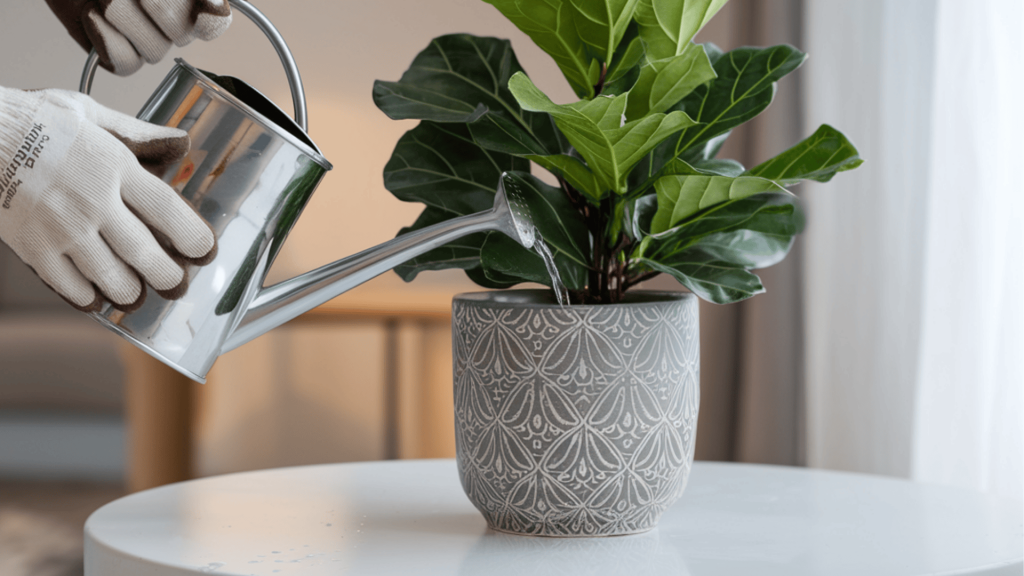
Water the plant the day before repotting. This softens the soil, making it easier to slide the plant out without damaging the roots. Support the stem at the base and carefully lift the root ball out, tilting the pot if it feels stuck.
Step 2: Loosen roots and add fresh mix
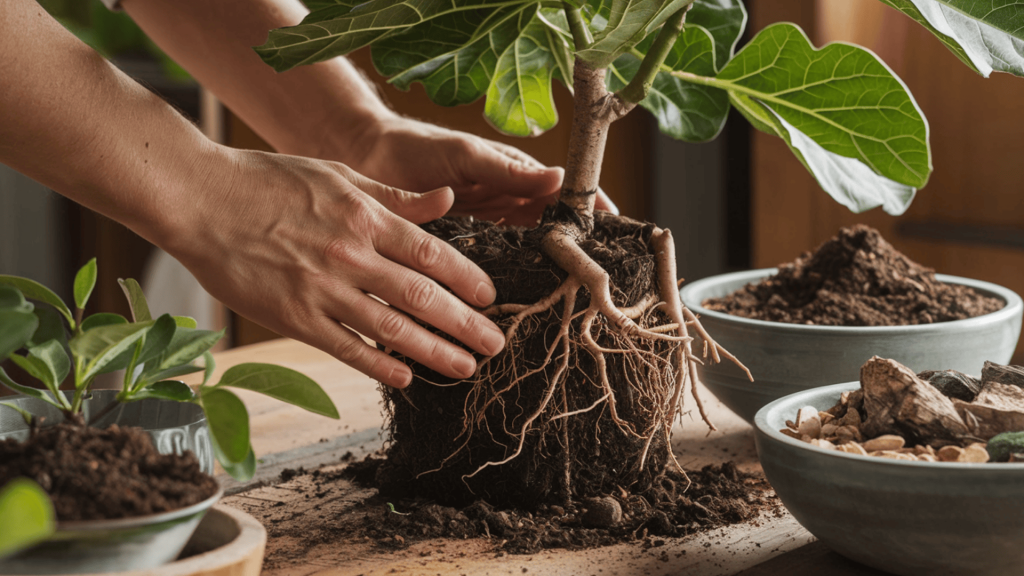
Gently tease apart any roots that are circling the root ball so they can grow outward in the new pot. Trim away dead, black, or mushy roots to prevent rot.
Place a layer of fresh soil mix in the bottom of the new pot, aiming for the plant’s crown (where the stem meets the roots) to sit at the same height as before.
Step 3: Set the plant and fill in
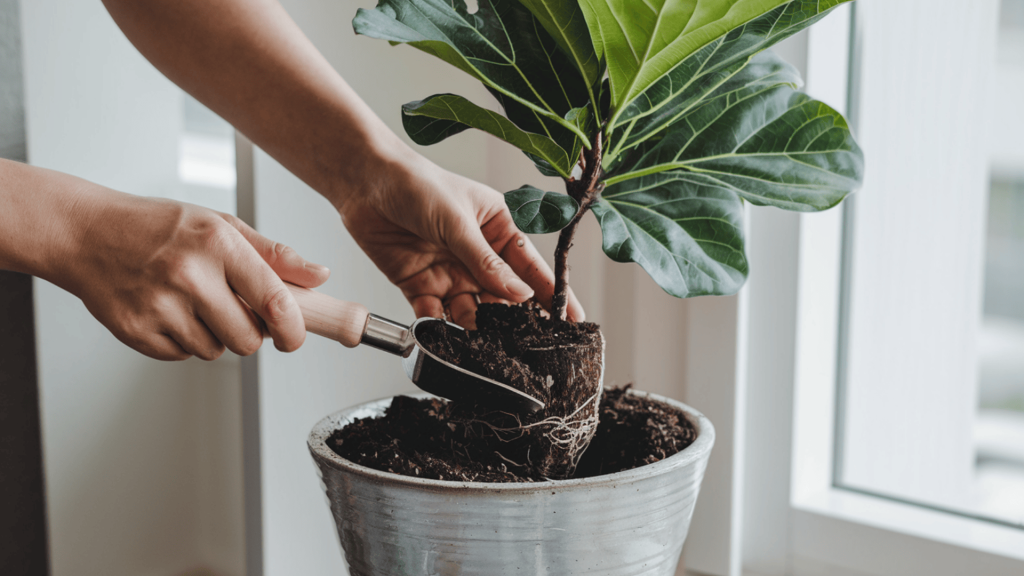
Position the plant upright in the center of the pot. Add soil around the sides, gently working it between the roots to eliminate air gaps.
Lightly press down to settle the soil, but avoid compacting it too much, as this can reduce airflow.
Step 4: Water and check for stability
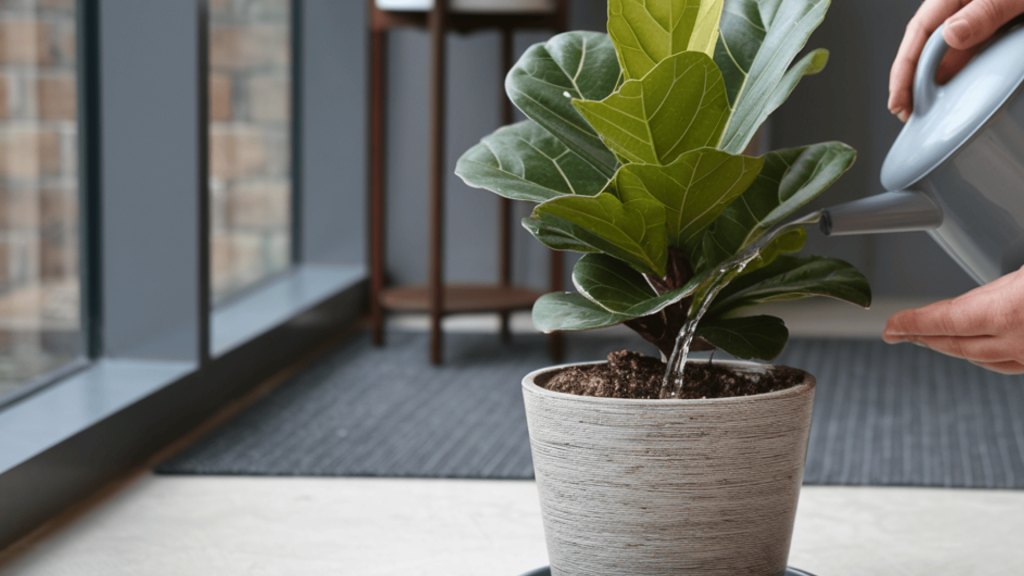
Water thoroughly until liquid drains from the bottom. This helps the soil settle around the roots and removes any remaining air pockets. Empty the saucer so the roots aren’t sitting in water. After about a week, check if the soil level has dropped and top it off if needed to keep the roots covered.
Preventing transplant shock
Place the repotted plant in bright, indirect light to help it recover. Avoid fertilizer for the first month so the roots can focus on establishing in the new soil. Water only when the top inch of soil feels dry, and keep the plant away from drafts or heat sources.
Ongoing Soil Maintenance
Keeping your fiddle leaf fig’s soil healthy over time helps prevent nutrient loss and root problems. You don’t always need to fully repot to give the plant a boost.
Remove the top 1–2 inches of old soil and replace it with a fresh mix. This adds new nutrients, improves aeration, and keeps the surface free from compacted or salt-heavy soil.
Signs soil needs replacing:
- Water is pooling on the surface instead of soaking in.
- A sour or musty smell is coming from the pot.
- Roots poking out of the topsoil or drainage holes.
- Leaves are yellowing or growth is slowing despite proper care.
Use a balanced liquid fertilizer during spring and summer. If your mix already contains slow-release fertilizer, wait 2–3 months before adding more to avoid nutrient burn. Always water before fertilizing to protect the roots.
Simple Fixes for Fiddle Leaf Fig Soil Troubles
Even with the right mix, issues can develop over time. Spotting and fixing them early helps keep your fiddle leaf fig healthy.
-
Root rot prevention and cure: Prevent root rot by using well-draining soil and a pot with drainage holes. Water only when the top inch feels dry. If rot occurs, remove the plant from the pot, trim all mushy or black roots, and repot in fresh, dry mix.
-
Compacted soil recovery methods: Compacted soil stops water and air from reaching the roots. Loosen it by gently poking holes with a chopstick or thin stick, then top-dress with a fresh mix. If compaction is severe, repot into a looser blend.
-
Fixing pH imbalance: If leaves yellow despite good watering and light, the soil pH may be off. Test it with a simple home kit. For soil that’s too acidic, mix in a small amount of garden lime. For soil that’s too alkaline, add peat moss or compost to bring it back to the ideal 6–7 range.
Regularly checking your plant’s soil and making small adjustments early can prevent bigger problems and keep your fiddle leaf fig thriving for years.
Conclusion
Healthy roots start with the right soil, and now I know exactly how to choose or make the best soil for fiddle leaf fig plants. With the right blend, your plant can grow stronger, avoid common problems, and look its best all year.
If you go for a ready-made option or try a DIY recipe, focus on good drainage, proper aeration, and balanced nutrients. I always check my soil regularly, refresh it when needed, and catch signs of trouble early.
You can do the same to keep your plant thriving. For more tips on plant care, repotting, and indoor gardening, check out other blogs on the website and keep learning how to give your plants the best start!





